Severan dynasty
The Severan dynasty was a Roman imperial dynasty, which ruled the Roman Empire between 193 and 235. The dynasty was founded by the general Septimius Severus, who rose to power as the victor of the Civil War of 193–197.
| Roman imperial dynasties | ||
|---|---|---|
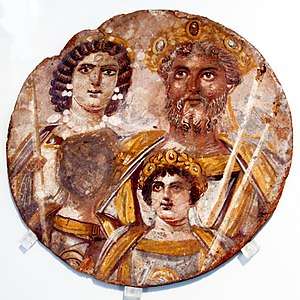 The Severan Tondo, depicting Septimius Severus and most of his family. | ||
| Severan dynasty | ||
| Chronology | ||
| 193–211 | ||
|
—with Caracalla 198–211 |
||
|
—with Geta 209–211 |
||
| 211 | ||
| 211–217 | ||
|
Interlude: Macrinus 217–218 |
||
|
—with Diadumenian 217–218 |
||
| 218–222 | ||
| 222–235 | ||
| Dynasty | ||
| Severan dynasty family tree | ||
|
All biographies |
||
| Succession | ||
|
Although Septimius Severus successfully restored peace following the upheaval of the late 2nd century, the dynasty was disturbed by highly unstable family relationships, as well as constant political turmoil foreshadowing the imminent Crisis of the Third Century. It was one of the last lineages of the Principate founded by Augustus.
History
- For dynastic relationships: see Severan dynasty family tree
Septimius Severus (193–211)
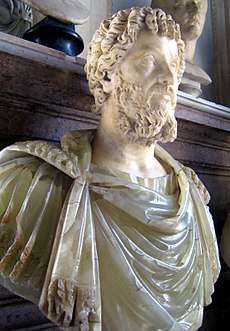
Lucius Septimius Severus was born to a family of Phoenicia equestrian rank in Leptis Magna, the Roman province of Africa proconsularis, in modern-day Libya. He rose through military service to consular rank under the later Antonines. He married Syrian noblewoman Julia Domna and had two children with her, Caracalla and Geta. He was subsequently proclaimed emperor in 193 by his legionaries in Noricum during the political unrest that followed the death of Commodus, he secured sole rule over the empire in 197 after defeating his last rival, Clodius Albinus, at the Battle of Lugdunum.
Severus fought a successful war against the Parthians and campaigned with success against barbarian incursions in Roman Britain, rebuilding Hadrian's Wall. In Rome, his relations with the Senate were poor, but he was popular with the commoners, as with his soldiers, whose salary he raised. Starting in 197, his Praetorian prefect Gaius Fulvius Plautianus was a negative influence, and he would be executed in 205. One of Plautianus's successors was the jurist Papinian. Severus continued official persecution of Christians and Jews, as they were the only two groups who would not assimilate their beliefs to the official syncretistic creed.
Severus died while campaigning in Britain.[1] He was succeeded by his sons Caracalla and Geta, who reigned under the influence of their mother, Julia Domna.
Caracalla (198–217)
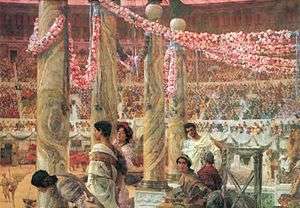
The eldest son of Severus, he was born Lucius Septimius Bassianus in Lugdunum, Gaul. "Caracalla" was a nickname referring to the Gallic hooded tunic he habitually wore even when he slept. Upon his father's death, Caracalla was proclaimed co-emperor with his brother Geta. Conflict between the two culminated in the assassination of the latter less than a year after their father's death. Reigning alone, Caracalla was noted for lavish bribes to the legionaries and unprecedented cruelty, authorizing numerous assassinations of perceived enemies and rivals. He campaigned with indifferent success against the Alamanni. The Baths of Caracalla in Rome are the most enduring monument of his rule. He was assassinated while en route to a campaign against the Parthians by a Praetorian Guard.
Geta (209–211)
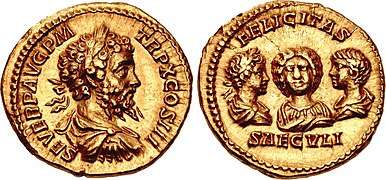

Younger son of Severus, Geta was made co-emperor with his older brother Caracalla upon his father's death. Unlike the much more successful joint reign of Marcus Aurelius and his brother Lucius Verus in the previous century, relations were hostile between the two Severan brothers from the very start. Geta was assassinated in his mother's apartments by order of Caracalla, who thereafter ruled as sole Augustus.
Interlude: Macrinus (217–218)
Marcus Opelius Macrinus was born in 164 at Caesarea Mauretaniae (modern day Cherchell, Algeria). Although coming from a humble background that was not dynastically related to the Severan dynasty; he rose through the imperial household until, under the emperor Caracalla, he was made Prefect of the Praetorian Guard. On account of the cruelty and treachery of the emperor, Macrinus became involved in a conspiracy to kill him, and ordered the Praetorian Guard to do so. On April 8, 217, Caracalla was assassinated travelling to Carrhae. Three days later, Macrinus was declared Augustus.
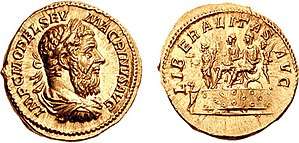
His most significant early decision was to make peace with the Parthians, but many thought that the terms were degrading to the Romans. However, his downfall was his refusal to award the pay and privileges promised to the eastern troops by Caracalla. He also kept those forces wintered in Syria, where they became attracted to the young Elagabalus. After months of mild rebellion by the bulk of the army in Syria, Macrinus took his loyal troops to meet the army of Elagabalus near Antioch. Despite a good fight by the Praetorian Guard, his soldiers were defeated. Macrinus managed to escape to Chalcedon but his authority was lost: he was betrayed and executed after a short reign of just 14 months.
Marcus Opelius Diadumenianus (known as Diadumenian) was the son of Macrinus, born in 208. He was given the title Caesar in 217, when his father became Emperor. After his father's defeat outside Antioch, he tried to escape east to Parthia, but was captured and killed before he could achieve this.
Elagabalus (218–222)
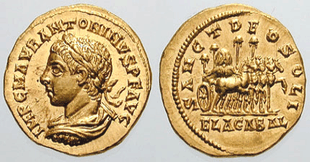
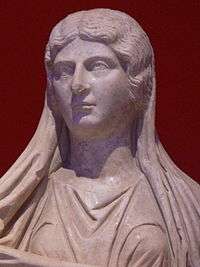
Elagabalus was born Varius Avitus Bassianus in 204, and became known later as Marcus Aurelius Antonius. The name "Elagabalus" followed the Latin nomenclature for the Syrian sun god Elagabal, of whom he had become a priest at an early age. Elagabal was represented by a large, dark rock called a baetyl. Elagabalus's grandmother, Julia Maesa, Julia Domna's sister and sister-in-law of Emperor Septimius Severus, arranged for the restoration of the Severan dynasty, and persuaded soldiers from The Gallic Third Legion who were stationed near Emesa, using her enormous wealth,[4] as well as the claim that Caracalla had slept with her daughter and that the boy was his bastard[5] to swear fealty to Elagabalus. He was later invited alongside his mother and daughters to the military camp, clad in imperial purple, and crowned as emperor by the soldiers.
His reign in Rome has long been known for being outrageous, although the historical sources are few, and in many cases not to be fully trusted. He is said to have smothered guests at a banquet by flooding the room with rose petals, married his male lover (who was thereafter referred to as the "Empress's husband"), and married a vestal virgin. Dio suggests he was transgender, and that he offered large sums to the physician who could give him female genitalia.[6]
The running of the Empire during this time was mainly left to his grandmother and mother (Julia Soamias). Seeing that her grandson's outrageous behavior could mean the loss of power, Julia Maesa persuaded Elagabalus to accept his young cousin Severus Alexander as Caesar (and thus the nominal Emperor-to-be). Alexander was popular with the troops, who increasingly objected to Elagabalus' behaviour. Jealous of this popularity, Elagabalus removed the title of Caesar from his cousin, enraging Alexander's protectors, the Praetorian Guard. Elagabalus and his mother were then assassinated in a Praetorian Guard camp mutiny.
Alexander Severus (222–235)
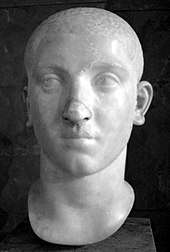
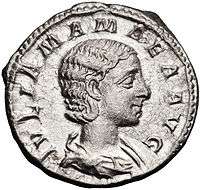
Born Marcus Julius Gessius Bassianus Alexianus in around 208, Alexander was adopted as heir apparent by his slightly older and very unpopular cousin, the Emperor Elagabalus at the urging of the influential and powerful Julia Maesa— who was grandmother of both cousins and who had arranged for the emperor's acclamation by the Third Legion.
On March 6, 222, when Alexander was just fourteen, a rumor went around the city's troops that Alexander had been killed, which triggered his ascension as emperor. The eighteen-year-old Emperor Elagabalus and his mother were both taken from the palace, dragged through the streets, murdered and thrown in the river Tiber by the Praetorian Guard, who then proclaimed Alexander Severus as Augustus.
Ruling from the age of fourteen under the influence of his able mother, Julia Avita Mamaea, Alexander restored, to some extent, the moderation that characterized the rule of Septimius Severus. The rising strength of the Sasanian Empire (226–651) heralded perhaps the greatest external challenge that Rome faced in the 3rd century. His prosecution of the war against a German invasion of Gaul led to his overthrow by the troops he was leading there, whose regard the twenty-seven-year-old had lost during the affair.
His death was the epochal event beginning the troubled Crisis of the Third Century, where a succession of briefly-reigning military emperors, rebellious generals, and counter-claimants presided over governmental chaos, civil war, general instability and great economic disruption. He was succeeded by Maximinus Thrax, the first of a series of weak emperors, each ruling on average only 2 to 3 years, that ended fifty years later with the Emperor Diocletian splitting the Eastern and Western Roman Empires.
Women of the Severan dynasty
The women of the Severan dynasty, beginning with Septimius Severus's wife Julia Domna, were notably active in advancing the careers of their male relatives. Other notable women who exercised power behind the scenes in this period include Julia Maesa, sister of Julia Domna, and Maesa's two daughters Julia Soaemias, mother of Elagabalus, and Julia Avita Mamaea, mother of Alexander Severus. Also of interest is Publia Fulvia Plautilla, daughter of Gaius Fulvius Plautianus, the Prefect Commander of the Praetorian Guard, married to but despised by Caracalla who had her exiled and eventually executed.
Dynastic timeline

See also
References
- Birley (1999), pp. 170–187.
- Mattingly & Sydenham, Roman Imperial Coinage, vol. IV, part I, p. 115.
- Mattingly & Sydenham, Roman Imperial Coinage, vol. IV, part II, p. 43.
- The Severan Women
- Icks, Martijn (2011). The Crimes of Elagabalus: The Life and Legacy of Rome's Decadent Boy Emperor. p. 11. ISBN 1848853629.
- Dio 74:16:7 "He carried his lewdness to such a point that he asked the physicians to contrive a woman's vagina in his body by means of an incision, promising them large sums for doing so."
Bibliography
- Anthony Birley., Septimius Severus: The African Emperor, Routledge, London, 1999. ISBN 0415165911
- Markus Handy, Die Severer und das Heer, Berlin, Verlag Antike, 2009 (Studien zur Alten Geschichte, 10).
- Harold Mattingly, Edward A. Sydenham, The Roman Imperial Coinage, vol. IV, part I, Pertinax to Geta, London, Spink & Son, 1936.
- Harold Mattingly, Edward A. Sydenham, C. H. V. Sutherland, The Roman Imperial Coinage, vol. IV, part II, Marcinus to Pupienus, London, Spink & Son, 1938.
- Simon Swain, Stephen Harrison and Jas Elsner (editors), Severan culture, Cambridge University Press, 2007.
Further reading
- Alföldy, Géza. 1974. "The Crisis of the Third Century as Seen by Contemporaries." Greek, Roman, and Byzantine Studies 15:89–111.
- Benario, Herbert W. 1958. "Rome of the Severi." Latomus 17:712–722.
- Birley, Eric. 1969. "Septimius Severus and the Roman Army." Epigraphische Studien 8:63–82.
- Campbell, Brian. 2005. "The Severan Dynasty." In Cambridge Ancient History: The Crisis of Empire (A.D. 193–337). Edited by Alan K. Bowman, Peter Garnsey, and Averil Cameron, 1–27. Cambridge, UK: Cambridge Univ. Press.
- De Blois, Lukas. 2003. "The Perception of Roman Imperial Authority in Herodian’s Work." In The Representation and Perception of Roman Imperial Power. Edited by Lukas De Blois, Paul Erdkamp, Olivier Hekster, Gerda de Kleijn, and S. Mols, 148–156. Amsterdam: J. C. Gieben.
- De Sena, Eric C., ed. 2013. The Roman Empire During the Severan Dynasty: Case Studies in History, Art, Architecture, Economy and Literature. American Journal of Ancient History 6–8. Piscataway, NJ: Gorgias.
- Langford, Julie. 2013. Maternal Megalomania: Julia Domna and the Imperial Politics of Motherhood. Baltimore: Johns Hopkins Univ. Press.
- Manders, Erika. 2012. Coining Images of Power: Patterns in the Representation of Roman Emperors on Imperial Coinage, A.D. 193–284. Leiden, The Netherlands, and Boston: Brill
- Moscovich, M. James. 2004. "Cassius Dio’s Palace Sources for the Reign of Septimius Severus." Historia 53.3: 356–368.
- Ward-Perkins, John Bryan. 1993. The Severan Buildings of Lepcis Magna: An Architectural Survey. London: Society for Libyan Studies.
External links
| Library resources about Severan Dynasty |